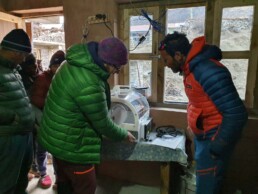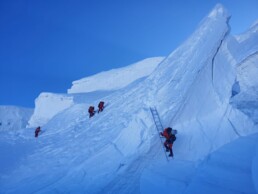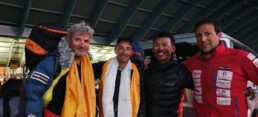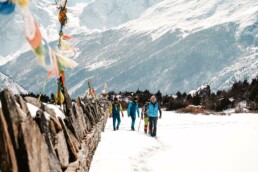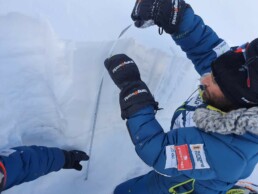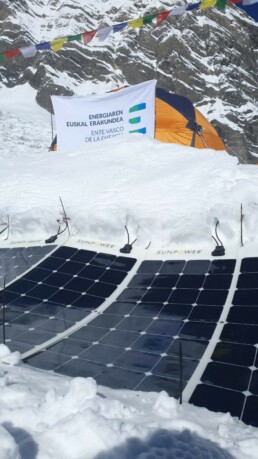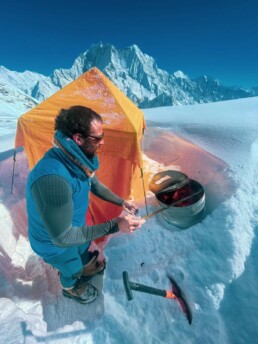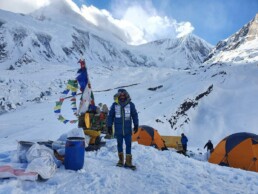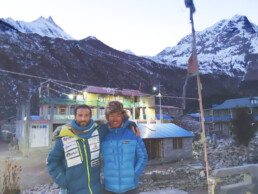There is no better gift than their smile and the sparkle in their eyes
Everyone, absolutely everyone, needs help at some point in their lives. Throughout my existence I have had the pleasure of meeting many people, each with their own story. Very hard stories. Stories that make you think. I promise you, that many of these testimonies have given me goosebumps, and have made me shed more than one tear... I am not exaggerating. As much as I want to, I can't even imagine what many of them have gone through. Thanks to everything I have seen and heard, I have realized how important it is to help, to collaborate, because with very little, we can change everything.
So, after reaching the top of Manaslu and a few days of rest in Kathmandu -although to tell the truth, we slept little, but we did recover from the great effort we had made-, we decided to return to the Base Camp to meet again with the residents of Samagaun. These people always made us feel very welcome and lend us a hand seems to me the least we can do.
On our return to the CB of Manaslu we were lucky to be in very good company, with friends. Specifically, among our group of 13 friends, there were 7 sanitarians (2 doctors and 5 nurses). During their stay they have been seeing patients and among all of us we have acquired some materials that are so useful to the local population. Medication, hygiene products... and two thermal beds. Yes, yes, you read that right... thermal beds, that is, some portable incubators that we have installed in Okjaldhunga Patle and Samagaun. Amazing.
Said like that, it sounds a bit strange, but I will put you in context. It is well known that technology is the key in terms of health advances, but unfortunately, it is very expensive, and therefore it is far from the economic possibilities of developing countries. What's more, among all those stories that I have told you before, there was one that stuck in my mind. Noa, a 33-year-old Nepali woman, told me with tears in her eyes that, in her village, premature babies fit into a shoebox or an empty pumpkin… Really sad. A shoebox or a pumpkin... that is for them what we know here as a conventional incubator, whose price can go up to 60,000 euros.
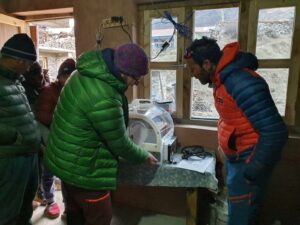
In the face of this reality, two young engineers from " Medicina abierta al mundo" set out and developed an accessible, open source and low-cost neonatal crib. Their work consists, among other things, of creating microchips that are implanted in the crib and with which they generate optimal humidity, light, oxygen and temperature conditions so that when the baby is born they can rest in ideal conditions. And believe me, in these remote rural areas, having these resources, especially in winter, can save (many) lives...
But here comes the best... This crib is foldable, has the size of a suitcase, weighs approximately 23 kilos and costs around 350 euros... The forerunners of this invention, convinced that the place of birth should not condition the possibilities of a newborn to get ahead, they have used simple materials and technologies so that it can be acquired and replicated anywhere in the world. In fact, if something goes wrong, an engineer can connect from Spain with the incubator's microchip and fix breakdowns and technical problems online. What's more, all the design and assembly information is shared on the internet so that whoever may need this product can manufacture it by their own means. Really, an invention!
But the merit is not his alone. Together with the NGO “Ayuda a contenedores” (which financially manage the project), and “Salesianos Pamplona” (who collaborate by designing the material through a 3D machine) they form the perfect trio. A trio that contributes their time and knowledge altruistically and that make possible this great project that continues to grow and save the lives of the little ones.
It is because of people like these that I still have faith in the human being... I think there are no words in the world to thank you for your work. And it is not easy to find people whose purpose is not to manufacture and sell, but to create and share their knowledge altruistically with the sole purpose of saving lives.
I promise, there is no money in the world that pays for those smiles, those looks of satisfaction and gratitude that the Nepalese families have given us when we have delivered all this material. That is the best memory that I take from this trip, without a doubt. An image that will always stay in my retina.
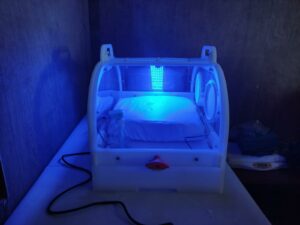
THANK YOU wholeheartedly
Not even know where to start…
Since I embarked on the winter expeditions, there have been many experiences, thousands of thoughts that have crossed my mind. But everything has fallen short after the summit of Manaslu on January 6, 2023. I think I have never had so many feelings together at the same time: joy, excitement, fear, nerves... They say that there are 26 feelings that you should experience at some point in time. life. I have experienced them in just two weeks.
On December 26, we set foot on the CB of Manaslu and 11 days later, we found ourselves at the top, at the highest point of the eighth highest mountain on the planet. I couldn't believe it, I had made the challenge that I had set myself in 2021 come true, I have lost count of the times I had imagined that moment, and finally, it has come true.
But it has not been easy. It has been one of the toughest, most demanding, and most dangerous climbs of my entire professional career. I've had a bad time, very bad to be honest, now I feel a certain emptiness, it's been three winters working on this project.
Now that I am safe and sound, rested and with a clearer mind, I would like to share with all of you my latest experience in the Himalayas. I'll try to be as brief as possible, I promise.
As you know, on December 26 we launched the Winter Summits project. Thanks to the two previous experiences we were able to see the terrain first hand. But that didn't stop us from spending hours and hours thinking about it, analyzing the best strategy. The only thing that was clear to us was that the ascent had to be as fast as possible to avoid any risk of frostbite. After a couple of rotations in height, the perfect moment has come. Despite the cold (we came to suffer temperatures as low as -50º) and the strong wind, it seemed that the weather was going to improve the next few days. We did not doubt it, we could not miss the opportunity. It was either now or never.
So on January 4, at 8:00 a.m., we took all the necessary material and put our backpacks on our backs. We went from Base Camp to Camp 1 and from 1 to 2. And here I make a point to comment that this section was, without a doubt, one of the most complicated I have done in my life. And considering the amount of meters that I have climbed in the Himalayas during all these years... Really, it was very hard, very complicated, it was very, very dangerous, much more than I thought...
And, having said this, I continue. We camped, spent the night and on January 5 we went from C2 to C3. Between the excitement, the nerves, the cold and the wind, we couldn't sleep a wink. But it didn't matter, so at 11:00 p.m., we left for the summit. And the rest... is history. 10 and a half hours later, that is, at 9:30 a.m. (local time) Pasang Nurbu Sherpa, Chhapel Sherpa, Gelu Sherpa, Maila Sherpa, Mantere Lama Sherpa, Gamje Babu Sherpa and I received the best gift from the Three Wise Men, a gift he had been waiting for 3 years. We were at the top, at the summit, at the highest point of Manaslu, the eighth highest mountain in the world. It is said soon...
But everything that goes up comes down, and we had to descend, we had to return to BC, because, as I always say, and I will never tire of repeating it... the true peak is achieved when the entire team returns safely to Base Camp. Once again, said and done. We began descending, little by little, without a doubt, this wasthe most difficult part of the challenge. And finally, at 6:00 p.m. we arrived at the Base Camp. Shattered, smashed. And it is that in less than 60 hours we had achieved the entire challenge. I was unable to assume what we had achieved.
I do not want to say goodbye without first highlighting the Polish expedition of 1984. All my respects to those climbers who, without the help of new technologies, managed to crown Manaslu. They had enormous merit. Nor do I want to forget about Simone Moro. Buddy, thank you for descending practically from C2 to CB alone, because as you commented, although you had enough strength to continue ascending, you considered that you could hinder the group when descending”.
Finally... I want to congratulate and thank all the people who have supported me during my career: family, friends, colleagues, clubs, mountain federations, sponsors... Without you this dream would never have come true.
THANK YOU wholeheartedly
Chronicles from Manaslu: final chapter
It has not been, far from it, the expedition we had in mind. If when our adventure began, on that distant December 13, someone had asked us what we expected from Manaslu 2022, none of us would have been able to foresee what we have experienced: two months of extremely intense snowfalls in which more than 4 meters of snow have accumulated and none good weather window. Simply, it has been impossible to even try. The mountain has not given us half a chance
When you prepare an expedition of these characteristics you try to put yourself in all possible situations. Of course, the one over all is to see you fulfilling the objective, but it is not, far from it, the only one or the most important. What we all hope for is to return home safe and sound and that, fortunately, we have achieved. At no time have we put our lives in danger.
Now, the fact that Manaslu did not open its doors to us at any time did not enter into any of our plans. We haven't had a single week of steady weather! It is true that our expeditions are carried out in winter and that the chances of snowfall and strong winds are higher compared to those that may occur in spring or summer. But this year has been crazy. When I will look back a few years from now and will remember this expedition, the first image to my mind will be the entire team shoveling snow non-stop trying to protect the base camp. We have had days where we have spent more than 16 hours shoveling snow without stopping. A crazy job that has not been rewarded
I have tried to see things from the positive side at all times. I wanted to believe that if we had had a very rainy January, February would be different. But it has not been that way. We have barely been able to climb a little higher than C1, at 6,500 meters. I do not mean to say that in two weeks of good weather we would have made it. You never know this. But we haven't even had the opportunity to play the game!
I will not deny it. We come back frustrated. Moving everything we have moved to come here and find this has not been a good deal. We can't do much more either. These are elements that we do not control. What I am proud of is having made the right decisions at certain times. What has been in our hands we have managed well. For example, what happened at the end of January. Seeing the amount of snow that was falling and after analyzing the risk of avalanches, we decided that the best thing for the safety of the group was to go down to Samagaun, the last village before reaching base camp. We went looking for shelter. A day later an avalanche took away part of the camp. We were not wrong. The mountain was very dangerous.
It has been two long months, during them we have tried to do everything possible. Finally, I would like to thank all the people who have encouraged me during these weeks. Your warmth has reached Nepal. Of course, I don't want to forget my collaborators and sponsors. Without you this would have been impossible. Finally, I would also like to thank Iñaki Álvarez and Iker Mediavilla, who have worked very hard and who have helped me a lot. And, of course, Eneko Garamendi and Sendoa Elejalde, who gave a lot to the expedition. Maybe next time. The mountains will still be there waiting for us.
Chronicles from the Manaslu: Chapter V
The weather is not making it easy for us. It never stops snowing. It is true that these last few days have given us a little truce, but the sky is cloudy again and we expect more precipitation between now and the end of the month. We weren't expecting so much snow, to be honest. In recent weeks more than 3 meters have accumulated and, of course, this makes it impossible for us to continue going up. For now. We are optimistic. Me I'm the first to be. I expect February to be a much drier month.
We are at the halfway point of the expedition. We did 40 days and we have still time. We are going to try until the end, but for that we need the snow to settle. We constantly measure the danger of avalanches and have even flown over several points in a helicopter to see the evolution. As I said, it has fallen a lot of snow and several areas are quite dangerous (on the European scale, 5/5). This is what is in the winter expeditions. We knew it in advance
I am optimistic by nature and I believe that the situation will change. Iñaki is also of the same opinion. Many times things look easy from the outside but when you get here the mountain decides for itself. It is what it is. We cannot fight against nature. We have to understand it and know how to interpret it. And, of course, be patient and wait for our moment. Adapt ourselves. I am sure that Manaslu will open its gates for us and we will be able to start climbing during the next few weeks.
Meanwhile we are still in Samagaun, the last village before reaching the base camp and which is located at 3,400 meters above sea level. The people have welcomed us with open arms and we are increasingly integrated into the local population. They treat us wonderfully. Their hospitality moves. Last week we even went to a funeral, during it a neighbor was fired. Buddhism never ceases to amaze us. It is completely different from what we are used to. The bright colors, the music… with each passing day we learn something new. Eskerrik asko Samagaun!
Chronicles from Manaslu: Chapter IV
One of the greatest dangers we face on winter expeditions is the risk of avalanches. It is a difficult phenomenon to predict and extremely dangerous. In a few seconds tons of snow begin to fall down and, if you are in the wrong place and time, it can be fatal. This year in Manaslu it is snowing a lot and the avalanches are continuous. We hear enormous roars and sometimes we feel the shock waves that they generate. The truth is, they produce a lot of respect.
To minimize risks, it is necessary to be prepared and take all possible precautions. Our friends from Elur (http://www.elur-equipment.com/) and Sergio Pérez Fernández are doing a very important job in this regard and we keep continuously in touch with them. They help us a lot. Safety is basic in any expedition and we have to try to read the mountain well. Try to predict when a route is safe and when it is not. I leave you with this text prepared by the friends from Elur team, which I believe explains very well the dangers of the mountains:
“As we already know, mountain activities involve a significant level of risk. This is even more present if we talk about mountains in winter, since we add new elements that can endanger our safety. One of the most lethal elements, and even more so when we talk about mountains as big as the ones we face in our expeditions, are avalanches.
During the current expedition of our colleague Álex Txikon to Manaslu in 2021-2022 the team is facing the hardest face of this mountain, since they have suffered snowfalls of more than 2 meters in Base Camp. These abundant precipitations, together with the fact that there is no stable base of snow in the deepest layers, mean that they are living with a 5/5 level of avalanche risk, the highest on the European scale.
As Álex has well said in many of his talks, 92% of mountain accidents are human-caused, that is, possibly avoidable. When we move in terrain with such a high risk of avalanches, it is important to follow a method based on having the correct equipment, training and recycling, having weather forecasts, analyzing the situation and making correct decision-making. As Álex says, the mountain will always be there and in a winter 8,000 mountain, there is no margin for error.
At Elur Equipment we are focused on the development of our avalanche rescue device, but we also work on the rest of this process, since if the analysis steps are done methodically and we bet on the safest option, we can avoid many high-risk situations and save lives
In addition, we do not want to miss the opportunity to thank Sergio Pérez Fernández for his invaluable help in analyzing the current situation at Manaslu.
As we always say, explore your limits, do it safe. "
Chronicles from Manaslu: Chapter III
An almost sustainable expedition is possible. We are doing it and, the truth is, it makes me tremendously proud. Seeing how all the electrical devices in the kitchen or the rest of the domes work thanks to solar energy comforts you. Our footprint will be minimal. In addition, there are times when we even have energy left over and we can share it with other tents. It's amazing.
Just ten years ago this would have been impossible. I believe that it can mark the way forward for future expeditions like ours. Being sustainable is possible and we have an obligation to follow that path. We owe it to these mountains that have given us so much. It is a step that all of us must take.
Working without generators or battery-operated light bulbs is also very comfortable. Ask Eneko, who no longer has to care the diesel to avoid running out of power while preparing the daily meal. Or talk to Sendoa, which recharges all his cameras and computers with power generated by the sun. I would say that we are one of the first expeditions that have energy 24 hours a day in base camp thanks to the sunlight.
All the electrical devices that we use are charged thanks to the plates that Fundación Eki has given us and the essential help of the Basque Energy Agency, which has contributed a lot to make all of this possible. Thanks for your help. Without a doubt, what we are achieving here is a milestone and we are doing it thanks to you. Eskerrik asko!
Chronicles from Manaslu: Chapter II
It has snowed as only here is usually seen. In just 36 hours we have found more than two meters of snow at base camp. It started snowing and hasn't stopped in three days. A pity, because we return to the starting box. It is time to reorganize the base camp, reopen the track and place bamboos, but we were aware that this could happen. There is no other choice but to smile, roll up your sleeves and keep working hard.
We were progressing at a very good pace. In fact, in just five days we had practically managed to ascend to C2. Iñaki and I were carrying up material when the snow began to fall. I decided to go back to BC that same night but Iñaki rested and came down next morning. It was a jug of cold water but the weather forecast, which marked snow, came true and we had to shovel snow for many hours.
Luckily BC was prepared for a situation of these characteristics. I always say that organizing it well is one of the keys to the success of an expedition, because you never know what can happen. We must be ready for strong winds or heavy snowfalls like the one that has fallen on us.
Of course, the tents resisted phenomenally. It is also true that you cannot sit idly by waiting for the storm to finish. You have to take the shovel and start removing kilos of snow. This is how we have been for almost 3 full days. We took a good beating
But it seems that the sun finally shines. After the storm we have some calm. It is time to put everything back together, reset what is our house and, when we do, look up. A lot of snow has fallen and we don't know the way the route will be. What we are sure of is that it will be much worse than a week ago and this will complicate everything a lot. But climbing Manaslu in winter is tough, very tough, and we have to prepare for it. We are really looking forward to it. This has just started and I hope to be back with good news in a few days.
Chronicles from Manaslu: Chapter I
We are working very hard at base camp. It's cold, very cold, and the first days in altitude are always difficult. But the Manaslu looks at us from above and that comforts us. It is as if every morning it says good morning and every night it helps us to rest. It is the first and last thing we see every day. We look at its face and feel that the mountain does the same. We say hello each other. We respect each other. We have a great challenge ahead. We cant’t wait for it.
It has been a busy and intense first few days. It all started with a thousand-hour drive, continued with a lot of paperwork, and finally we arrived in Kathmandu. We spent 4 nights there, in which we took the opportunity to do logistics work (we organized more than 130 packs), legal work (we got the necessary permit for ascent) and do one of the most beautiful and rewarding things there is: helping local people. We did it thanks to various associations and NGOs that do a commendable job and that we know well from years ago. I love to contribute with my grain of sand, although I know that it cannot be compared with what they do. They do an impressive job. I write these lines and I can't help but get excited
We donate computers to 'SOS Himalaya Foundation: Iñaki Ochoa de Olza Foundation', which works with the objective of finalizing the unfinished cooperation projects of the Navarrese mountaineer. We deliver several new laptops that will surely be usefull. And, as on previous occasions, we help also Udana Nepal Foundation, which was created with the purpose of preventing situations of injustice and inequality suffered especially by girls, women and the most vulnerable groups in impoverished areas such as Nepal.
We had a very beautiful and really exciting day with them. Udana Nepal team help a lot to a sector that is practically invisible in Nepalese society. We, for our part, take the opportunity to climb for a while with them in a climbing wall. I think they had a great time and did something different. Their smiles made our day so happy.
Finally, we got to know first-hand the work carried out by Hugging Nepal Foundation. We were lucky enough to see the work they do and, to be honest, it shocked us a lot. They feed people without resources, who thanks to the foundation are able to eat at least one quality meal a day. During the pandemic, they have had very long queues of people who had nothing to put in their mouths. This queue is called 'the queue of shame'. In a country like Nepal the different social classes do not come together and, if they see you in that queue, it is because you are not doing well at all. Seeing all this has been a very hard but it’s the reality.
And after 4 days of paperwork, organizing cargos and learning about the work of these associations, we headed to Samagaun, last village before reaching Manaslu base camp, which is located at an altitude of more than 3,000 meters. This year we have decided to go up by helicopter and we have done it for several compelling reasons. The first because the health and safety measures advised it to do so. The less interaction we have with the people here, the better for them and for us. We cannot risk infecting them. Although we carried out several PCR tests throughout our stay in Kathmandu, it was advisable to have as little interaction as possible with the villages along the way.
On the other hand, we took advantage of the helicopter trip to help several elderly people and children to go down from Samagaun to Kathmandu (in total there were more than 30). Winter in Samagaun is very hard and being able to bring these people down to the capital has been very important. There they are more sheltered. If it hadn't been for these helicopter trips, they would have taken a long time to walk down and many of them would have been forced to spend the winter in harsh conditions in this remote village.
Our stay in Samagaun also helped to gradually acclimatise us. We made short trekkings in the mountains and bivouacked one night at an altitude of 4,300 meters. It has been a beautiful night for us. Eneko and I were very comfortable.
At the moment we are working in our base camp, leaving everything ready. Our experience has taught us that setting up a good camp is one of the keys to success. As I said at the beginning, it is very cold. Last year we reached this same point in mid-January and we don't remember these temperatures. But this is what we have come to. We will continue working hard. The Manaslu awaits us.
Chhepal Sherpa: “At my age, I’m 38, and after climbing a lot, I feel really good, with enough experience for this new challenge”
The world of mountaineering would not be possible without the Sherpas. That's something I've always said. They are a key element of this sport that I respect and love so much. They know the mountain; they will be there to save your life and give you the best advice. That is why I would like you to hear what one of them has to say. This is Chhepal Sherpa. A great colleague on the mountain and a great friend. Here are his thoughts.
Chhepal, how come you are here this winter?
First of all, I´m a climber and fortunately these last 5 years I´ve been on winter ascents: Everest twice, K2, Amadablan and Manaslu last year. This year, I’m here with my team: Tenjin Sherpa, Pasang Norbu Sherpa, Gyalu Sherpa, Thinduk Sherpa and, if we need some help, we also have Pemaba Tashi, our cook, who can also cooperate with us on the mountain.
How many teams will be on the Manaslu?
We are professional climbers. This year we are going to try Manaslu in winter.
Last year, Pasang Norbu refused to go with you (Alex) because he really wanted to climb K2 in winter. Fortunately for us, we have got private financial support for seven summits, which also helps us.
As you have seen lately in the media, Gelje Sherpa is organising a winter attempt on Cho Oyu with Nepali climbers, who are very strong. Last winter, Pasang Norbu went nonstop from the base camp to C4, and also nonstop to the summit of Dhaulagiri. There is also a team of Nepali climbers who want to reach the real summit of Manaslu and we are really motivated about that.
So Chhepal, how many teams are there on the mountain?
More than one. My team will work together with your team, Alex (Txikon, Iñaki Alvarez and Simone Moro), plus sherpa Pasang Rinji. Then, there is an international team with Paula Birgitta, and Mingma Sherpa. Then, Sofie Lenaerts and her husband Steven Maginelle plus Dawa Sherpa team and, finally, Oswaldo Pereira´s team.
But how are we going to organise it all? On the one hand, we are a climbing expedition, on the one hand, there is a commercial expedition?
Alex, we are winter climbers thanks to you. My first winter experiences were with you. We started in winter because of you. Gelje Sherpa or Gesman Tamang or others took their first steps in winter with you. You always make a team. I have learned to create a strong team in the mountain. For sure we will cooperate with your team. Oswaldo is also a very good man, and he is always ready to help. The rest are in the same base camp.
Your second question, the commercial expedition: Sofie’s or Paula’s sherpas are there to assist them all the time. It will be a commercial venture but if they work all the time like us or the rest of the team, it will not be commercial.
About commercial expeditions; in my experience, many people come to Nepal with many sponsors usually in the spring and autumn and wait at the base camp until we Nepalese do the work of placing the ropes above 8,000 metres. In the meantime, they do nothing but post pictures and information on their social media profiles, hiding the reality.
But Alex, I am very confident and convinced that everyone will cooperate.
¿What did you learn from last year on Manaslu?
Last year we were a strong team. This year, I think we will be stronger because more climbers are coming, but let’s see what will happen. Last year I saw you, like always, work very hard. Iñaki also worked very well in the second part of the expedition. Simone has a fast style going up and down, and he works well too at lower altitudes.
Sorry, what route would you like to take?
I prefer the normal route, because we will have less work than last year.
Last year, I also learned to focus on the right moments, on saving energy and being patient as I always am.
I would like to add that the base camp will soon be established by the porters and our cooking staff, but with your (Alex Txikon) and Nati’s brains. You managed to get everything to Samagaon. You managed to move up local porters because you gave everyone headlamps. I´m so happy to be with you again.
How do you feel Chhepal?
Now, at my age, I’m 38, and after climbing a lot, I feel really good, with enough experience for this new challenge.
Thank you very much, Chhepal.
Thanks to you too, and I’m excited to work on the mountain with your team. Let’s enjoy the next few weeks.

